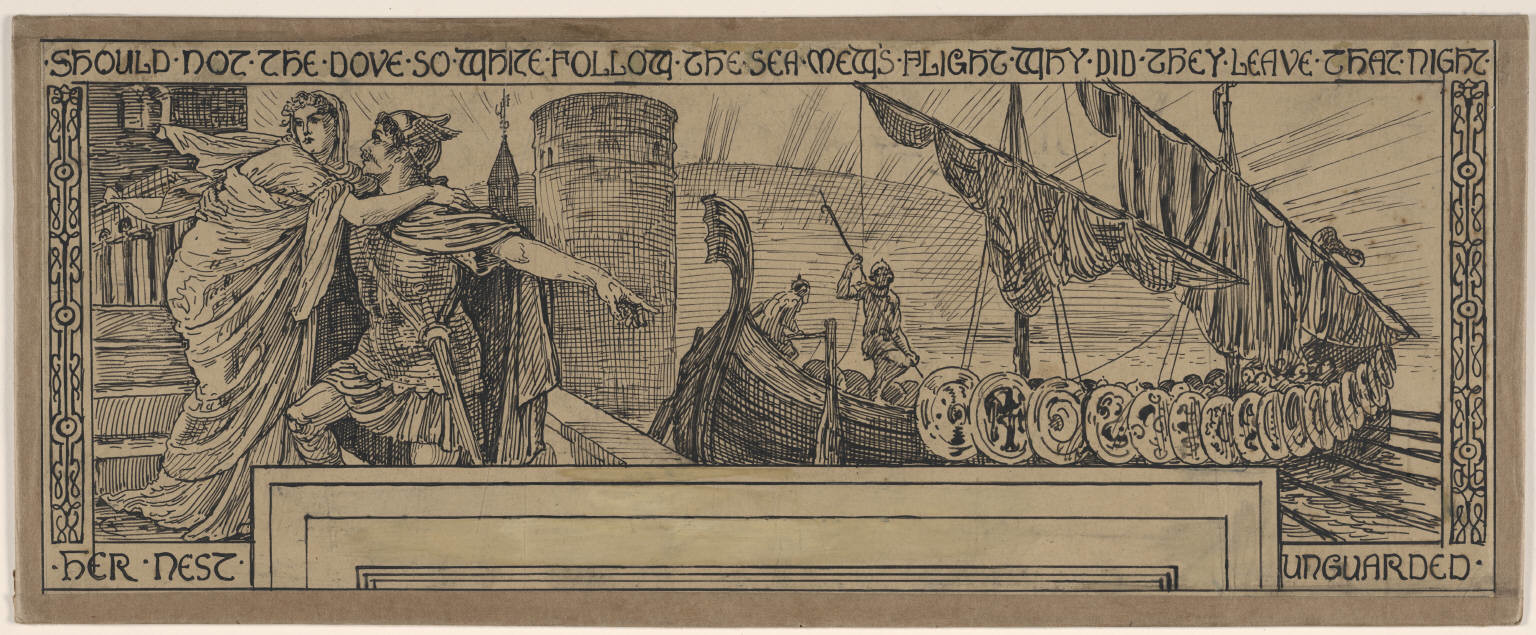Morris & Co. and Walter Crane Crossing the Pond
March 24, 2011 marked the 177th anniversary of the birth of William Morris (1834-1896), the incredibly versatile and prolific British poet, artist, manufacturer, socialist, and designer. Morris is perhaps most commonly remembered as the designer of brightly colored textiles and wallpapers, however, his breadth of artistic vision encompassed much, much more and reached into virtually all possible areas of production. Just as abstraction and nature intermingled in Morris’s and his associates’ work, so too were literature and history, myths and legends interwoven with real life.
In the early 1870s, Morris became intensely interested in Iceland, learning and translating the language and, in 1871, traveling to Iceland in order to experience the culture and folkloric history for himself. By that time, Morris had already lived by his own maxim, “Have nothing in your houses which you do not know to be useful or believe to be beautiful.” Since his student days at Oxford, he and his fellow student and roommate Edward Burne-Jones had been designing unified decorative schemes and decorating their own living spaces with handpainted murals and handcrafted furniture.
It is particularly fitting, then, that a little over a decade later the products designed and sold by Morris & Co., or ‘the Firm,’ were gaining widespread popularity in England. They were also increasingly garnering attention in the U. S., which led to a number of commissions in the States. By the 1880s, Newport, Rhode Island - a bustling port city - was attracting the Gilded Age elite in droves. Many built summer “cottages” on the water. In 1882, Catharine Lorillard Wolfe - then the single richest woman in America - commissioned the American architectural firm of Peabody & Stearns to build her dream house, and ‘the Firm’ of Morris & Co. was chosen to provide much of its interior decorative scheme. Lorillard Wolfe admired the Old Stone Mill in the center of Newport, which was thought to be evidence of the Viking settlement along the North American coast. In 1841, the American poet Henry Wadsworth Longfellow wrote a poem “The Skeleton in Armor,” in which he refers to Newport’s Old Stone Mill and intertwines this architectural ruin with news reports of a skeleton outfitted in armor which had been unearthed in Fall River, Mass in 1832. With all of these influences in mind, Lorillard Wolfe named her Newport cottage “Vinland,” in honor of this Nordic past, and its architectural details and interior design were directly inspired by this surge in interest in Viking history.
Fittingly, Morris & Co. worked on various aspects of this commission, including stained glass windows, carved furnishings, and textiles. Beinecke owns a key part of this puzzle. Walter Crane, the renowned British artist and socialist, agreed to provide a large-scale mural for Vinland, painting a frieze that went around the upper border of the dining room. Beinecke has a series of preparatory drawings or black and white illustrations by Crane which tell Longfellow’s story of the Viking Bride. Thus we can see this legend of the romance between a “blue-eyed maid” and her beloved Viking soldier come to life. –Adrienne Sharpe (adrienne.sharpe@yale.edu)
For more information: Adrienne Sharpe, “Rediscovering Vinland, Pre-Raphaelite Society Newsletter, Summer 2007.
Images: Crane portfolio (above: Uncat MS Vault Crane); Longfellow’s Skeleton in Armor, Boston: Osgood & Co., 1877 (below: Za L860 877s)
Adrienne Sharpe has an MA in Design History from the Bard Graduate Center in NYC, and is a Governing Board member of the William Morris Society in America. More information on Morris and the Morris Society in the US can be found here: http://www.morrissociety.org/; http://www.facebook.com/pages/The-William-Morris-Society/138704472341?ref=mf



